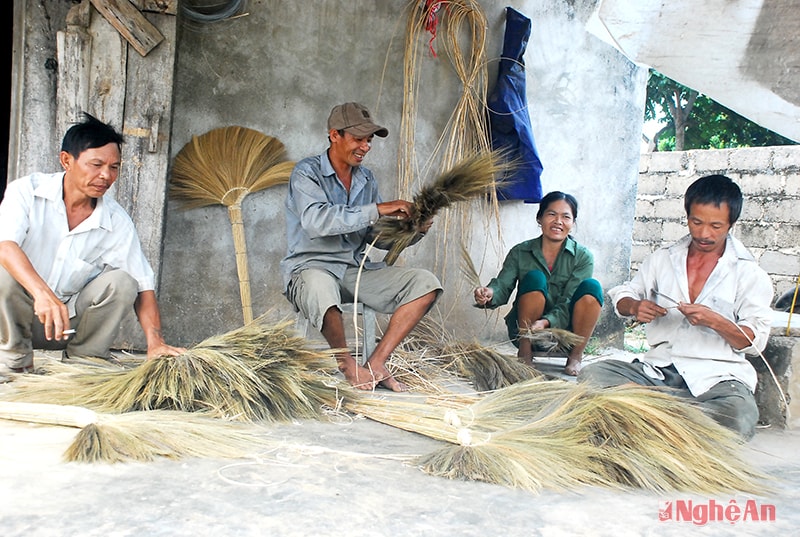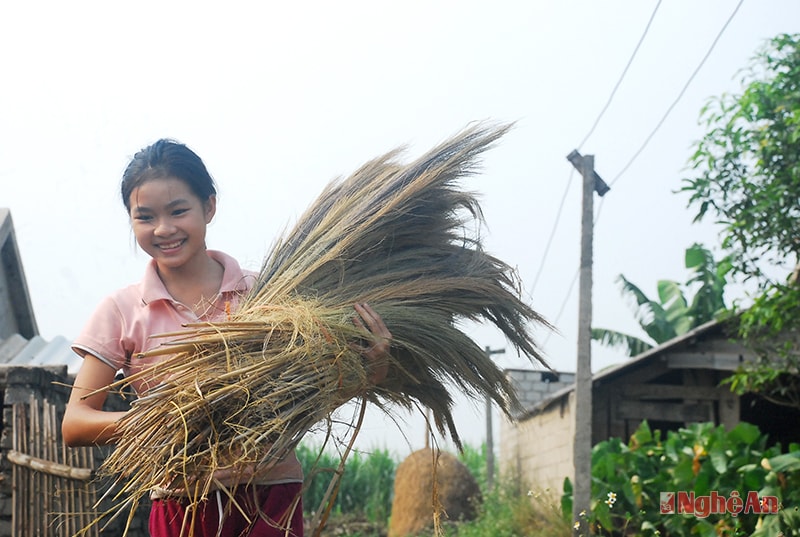Hoa Hoi: Bustling reed seasons
(Baonghean) - Hoa Hoi village (Nghia Hoi, Nghia Dan) appeared before our eyes after the long dike with red tiled roofs, green mustard gardens shining in the sun and large yards bustling with voices and laughter. For many years now, that bustling atmosphere has never disappeared from this countryside, even though the broom making profession has had its ups and downs...
 |
| A broom making place in Hoa Hoi. |
We stopped at the porch of a 76-year-old man named Phan Son, who was both skillful and talkative. He said that he had been involved in the broom making business since... birth. It is not an exaggeration to say that, because when he was born, his ears already rang with the thumping sound of beating reeds. His grandmother's hair and father's shirt were stained with reed dust. Reeds covered the house and the alley. At that time, the Hoa Hoi people only knew how to make brooms for home use, not for business like now. Then, there came a time when a few houses in the village made brooms and hung them on steel wires in front of their yards with signs on cardboard or small pieces of wood: "Brooms for sale". Hoa Hoi village began to have an "economic mindset" with such signs.
When the first broom was asked to buy and was praised for its beautiful weave, the Hoa Hoi people were extremely excited. The first brooms were exchanged for butter, rice, bunches of rice, oil lampshades... From that simple exchange and trade, strength, confidence and passion for broom making were created. At that time, whether the family was hungry or well-off, they all "invested" in building a warehouse to store reeds and sedges. It was called a warehouse but it was actually a small house roofed with dry straw. Every two or three harvest seasons, people changed the thatched roof to avoid rain and storms from wetting the reeds and brooms.
A couple of times a month, people go up the slopes of Quy Hop, Quy Chau, Que Phong to find reeds. Mr. Son said that the thumping sound of people hitting the reeds to make them fall is the most familiar and memorable sound in the lives of the people of Hoa Hoi village. Mr. Son could not remember how many times he went into the forest to pick reeds and was bitten by slugs and leeches, how many times his shoulders were scratched and bruised from carrying reeds and squeezing rice balls to share on rainy and windy nights in the middle of the forest... Then under the moonlight, next to the oil lamp, the people of Hoa Hoi sat diligently tying reeds. There were times when the products of the craft village seemed to have no "output", brooms were piled up in the warehouse, but the people of Hoa Hoi were not discouraged and could not give up the profession.
Having been involved in the profession since the most difficult years, building the “brand” of Hoa Hoi brooms is not easy or quick. Hoa Hoi people tell each other, we still do the profession anyway to ease the... nostalgia and also to preserve the image of a craft village with skillful people famous in the region. Even if it eases the nostalgia, it is not only to ease the nostalgia for the profession, but also to live in the bustling atmosphere with reeds. “It’s like me,” Mr. Son said. “Now, my job is not to earn a living like before, but because I love the broom making profession so much that I feel sad every day without touching the bamboo or reed. Hoa Hoi village is always bustling with laughter, even when the brooms that have not been sold out, sometimes each family can only sell five or seven brooms a week, but that doesn’t make anyone feel discouraged or discouraged. Only then do we know that the broom making profession is not just about earning a living and educating children, but also about passion and belief in the profession of journalism...”.
 |
| Help mom dry the clothes. |
A beginner can only make five or seven brooms a day, while a skilled person can make up to three or four dozen a day. First, split the bamboo and choose the steel (spar and steel used to tie the broom handle). Before tying the broom, you must choose even-sized reeds. Big reeds make big brooms, small reeds make small brooms. This way, the broom will be strong. If you tie the whole broom together, it will be impossible to tie it tightly. If you want a beautiful broom, the craftsman always shakes the dust off the reeds until there is no more dust before tying them together. The same goes for reeds, you must choose reeds that are even and strong. There are brooms with stems made from reed stems, and some with stems made from plastic handles (because some consumers prefer plastic stems). The craftsman must choose reeds that are even, use plastic or steel wire to tie them tightly, so that when you hold them, they will be firm. Normally, a reed broom that sweeps a lot can be used for five or seven months...
Mr. Son added that in Hoa Hoi, there are people who are very passionate about making brooms. For example, Mr. Tuat's house. On the long road of straw, we came to Mr. Pham Van Tuat's house. Although he never spent years going up the forest with his father to find brooms during the blooming season, since childhood, he has known how to help his parents make brooms every night. Then he got used to the hands, got used to the work, loved and attached to the broom making profession as a natural thing - Mr. Tuat confided. "Following the career" of making brooms from his parents, until he got married and had children, for 25 years now, Mr. Tuat has hardly had a day when he did not make brooms. And it is impossible to count how many brooms he has made. Currently, he and his wife take broom making as their main occupation, on average each day they make 30-40 brooms. On average, each year they earn about 30 million VND...
It is not exactly a rich profession, but in Hoa Hoi, the broom making has helped many families to rise up, escape poverty, and help their children have money to study. The family of Mr. Tran Van Phuong, has two children studying at Hanoi University of Construction and Ho Chi Minh City University of Economics, thanks to the income from their parents' broom making. Mr. Phuong said: "The good thing about the broom making profession is that we can still do it, rain or shine, and still earn money. You see, in Hoa Hoi, every family makes brooms together, today is the harvest season so everyone goes to harvest, otherwise it would be very crowded. During the day, we make brooms under the shade of trees, on the porch, at night we work in the yard, working together is both fun and effective. The good thing is that people love and help each other, when one family finds a place to sell, they immediately inform the other, so the village and neighborhood are very close." And not only Mr. Phuong's family, every year, in Hoa Hoi village, there are 5-6 children who pass the university entrance exam, not to mention the number of children studying in colleges, intermediate schools or vocational schools thanks to their parents' broom weaving profession, so they can study with peace of mind.
Mr. Pham Van Hao - Head of Hoa Hoi broom making village said: For a long time, when mentioning Hoa Hoi, people have been mentioning brooms. Hoa Hoi broom making village was formed in the 70s and 80s of the last century. Through the development process, from the place where people only knew how to produce brooms for consumption, they have now switched to producing goods. Currently, the whole village has 98/113 households doing the job, with 198 main workers and more than 200 secondary workers. Realizing that the broom making profession has many advantages, such as simple production area, not dependent on the weather and especially taking advantage of local human resources, currently, in Hoa Hoi village, almost every house has someone making brooms. Along with rice cultivation, broom making is considered the main income profession (accounting for 65%) of families. Notably, on December 31, 2007, Nghe An Provincial People's Committee signed a decision to recognize Hoa Hoi village as a broom making village. Since then, everyone in the craft village has been happy and excited, trying to improve their skills to make quality products that are loved and trusted by the market...
Currently, Hoa Hoi village is considered the most prosperous village in the whole commune. Every year, the whole village exports about 500,000 brooms, earning a profit of 3 billion VND; the average income per capita is nearly 30 million/person/year.
There are many joys, but there are also many worries. That is the increasingly scarce supply of raw materials for the craft village, as well as the increasingly difficult demand for exporting brooms to the market. Although it has been recognized as a craft village for 7 years, the collective organization of Hoa Hoi broom craft village is still fragmented and inconsistent, each person does their own thing. For a long time, the raw material source of thatch has been collected by households more than 200 km up to the mountainous district of Ky Son, near the Vietnam - Laos border gate; the fastest households can buy a lot, while the less fortunate households have to wait for the next shipment. When the broom products are exported, the people themselves go to find markets throughout the province and outside, which is very difficult and time-consuming.
“The people's expectation, as well as the determination of the People's Committee of Nghia Hoi commune in maintaining and developing the Hoa Hoi broom craft village, is to soon establish a small-scale handicraft cooperative that works regularly, systematically, and is assigned specific and clear tasks, so that broom makers can grasp the rules of the craft village's operations, and at the same time feel secure in production without having to worry about a lack of raw materials or finding customers...”, said Mr. Dau Khac Long - Chairman of the People's Committee of Nghia Hoi commune.
Article and photos:Thu Huong






